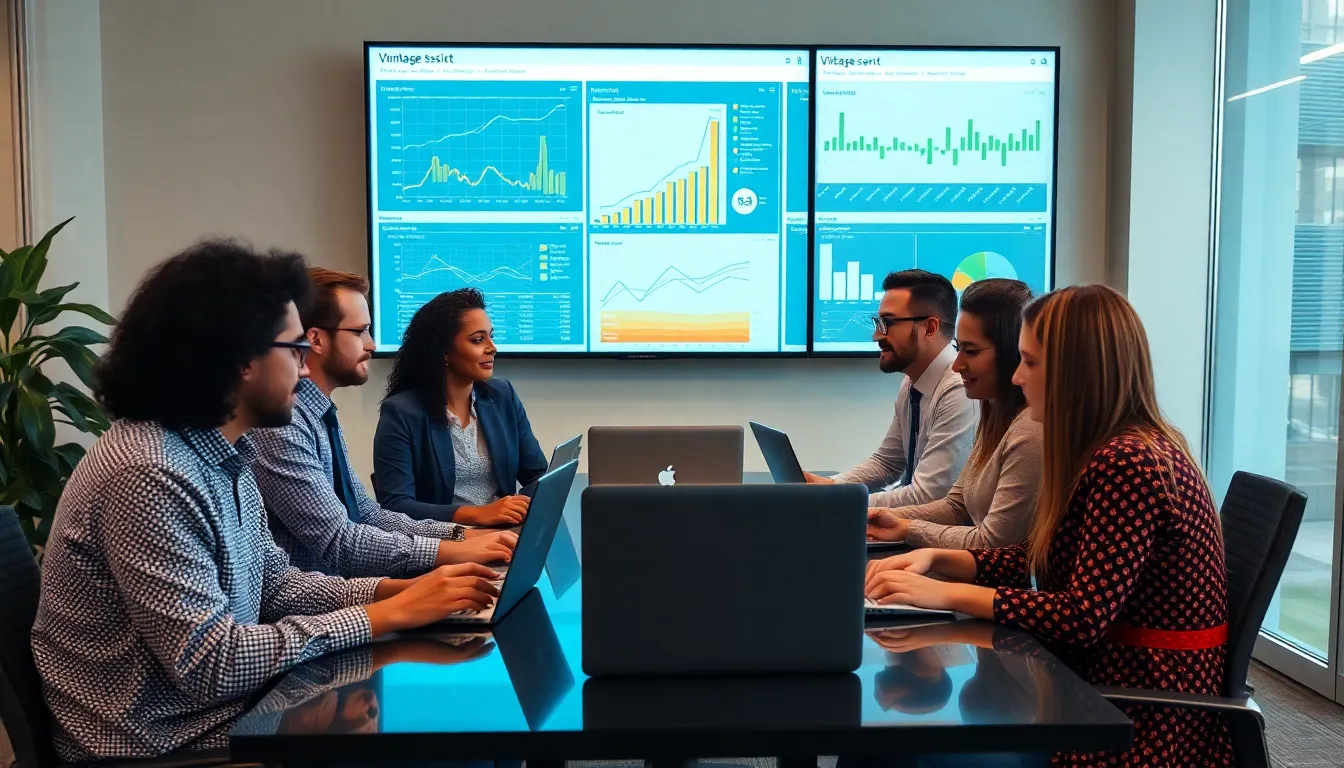In a world where cyber threats lurk around every corner, vulnerability management isn’t just a techie buzzword; it’s the superhero cape your organization needs. Picture this: your network is like a fortress, but what if there are secret passageways that hackers can waltz through? That’s where vulnerability management swoops in to save the day.
Table of Contents
ToggleOverview of Vulnerability Management
Vulnerability management plays a key role in safeguarding networks against cyber threats. It identifies and mitigates potential weaknesses that hackers may exploit.
Definition and Importance
Vulnerability management refers to the continuous process of identifying, evaluating, treating, and reporting security vulnerabilities in systems and software. The importance of this process cannot be overstated, as active management enables organizations to reduce their risk exposure significantly. It protects sensitive data, maintains compliance with regulations, and enhances overall security posture. Organizations with strong vulnerability management practices experience fewer security breaches, prompting better trust from customers and stakeholders.
Key Components of Vulnerability Management
Key components include discovery, assessment, remediation, and reporting. Discovery involves scanning networks and systems for vulnerabilities. Assessment evaluates the severity and potential impact of identified vulnerabilities. Remediation focuses on applying patches or implementing workarounds to mitigate risks. Reporting provides insights into the vulnerability landscape, helping organizations make informed decisions. Prioritization of vulnerabilities based on their risk levels ensures that critical threats are addressed first.
Vulnerability Assessment Process

The vulnerability assessment process involves systematic steps to protect an organization’s digital assets. It focuses on identifying weaknesses in systems to enhance security measures.
Identifying Assets
Identifying assets starts with cataloging software, hardware, and network components within the organization. Critical systems, such as databases and web servers, require special attention. Each asset needs a clear understanding of its importance and potential impact on operations. Asset inventory tools streamline this process by providing a comprehensive view of the IT environment. Keeping this information up to date ensures that organizations are aware of changes that could introduce new vulnerabilities. Knowledge of assets allows teams to prioritize their assessments effectively.
Scanning for Vulnerabilities
Scanning for vulnerabilities utilizes automated tools to detect security weaknesses across the network. Regular scans, scheduled monthly or quarterly, help maintain a proactive security posture. Various scanning tools, such as Nessus or Qualys, identify vulnerabilities and misconfigurations based on known threats. Each scan provides detailed reports on identified issues, facilitating prompt corrective actions. Organizations can focus their remediation efforts on high-severity vulnerabilities, thereby minimizing risk exposure. Consistency in scanning ensures that newly discovered vulnerabilities are accounted for in real time.
Analyzing Vulnerability Data
Analyzing vulnerability data involves evaluating the information collected from scans to identify patterns and critical risks. Risk scores assigned to vulnerabilities help prioritize which ones demand immediate attention. Contextual factors, such as asset importance and potential business impact, play a significant role in this analysis. Organizations can adopt frameworks like CVSS (Common Vulnerability Scoring System) to standardize their assessment of vulnerabilities. Collaborative discussions among IT and security teams further enrich understanding and drive effective remediation strategies. This step ensures that vulnerabilities are addressed efficiently, safeguarding sensitive data.
Remediation Strategies
Effective remediation strategies are essential for minimizing risks associated with vulnerabilities. Organizations rely on a methodical approach to address and mitigate issues promptly.
Prioritizing Vulnerabilities
Prioritizing vulnerabilities facilitates focus on the most critical threats. Organizations assess risk levels using frameworks like the Common Vulnerability Scoring System, which assigns scores based on severity and potential impact. High-severity vulnerabilities demand immediate attention, especially those that affect critical assets such as databases and web servers. Risk scores should consider asset importance and business implications, guiding remediation efforts effectively. Consultation between IT and security teams enhances understanding of risks, ensuring resources are allocated appropriately to high-risk vulnerabilities.
Patching and Mitigation
Patching and mitigation form the core of effective vulnerability management. Routine patch management schedules ensure timely updates, reducing the chances of exploitation. Automated systems can streamline this process, pushing critical patches to vulnerable systems with minimal disruption. Organizations assess the relevance of each patch, considering its compatibility with existing systems. In some cases, alternative mitigation tactics such as configuration changes or access controls may be necessary to address vulnerabilities that cannot be patched immediately. Implementing these strategies significantly lowers exposure to potential threats.
Verification and Testing
Verification and testing confirm the effectiveness of remediation measures. Organizations conduct post-remediation scans to ensure vulnerabilities have been resolved. This step validates that patches and mitigations perform as intended, preventing potential security breaches. Routine testing can take various forms, including penetration testing and vulnerability scanning. Such assessments help identify any remaining vulnerabilities or new risks introduced. Continuous improvement is critical; organizations review and refine their remediation strategies based on test results, ensuring a robust security posture over time.
Tools and Technologies
Organizations leverage various tools and technologies to enhance their vulnerability management efforts. Effective solutions streamline processes, improve security, and ensure thorough assessments of their digital environments.
Vulnerability Scanning Tools
Vulnerability scanning tools play a crucial role in identifying security weaknesses. Nessus, Qualys, and Rapid7 offer automated scanning capabilities, detecting misconfigurations and vulnerabilities across networks. Regular scans, conducted monthly or quarterly, maintain a proactive stance against potential threats. Each scan generates comprehensive reports detailing identified vulnerabilities, helping organizations prioritize issues based on severity. Prioritization based on risk levels ensures that critical threats receive immediate attention, thereby enhancing overall security.
Threat Intelligence Platforms
Threat intelligence platforms provide contextual data on potential threats, enriching vulnerability assessments. These platforms aggregate threat data from multiple sources, including open-source feeds and proprietary databases. By analyzing this data, organizations can identify emerging threats and their potential impacts on their assets. Integration of threat intelligence with vulnerability data allows for a more informed prioritization process, targeting vulnerabilities that hackers actively exploit. Using this information empowers teams to address high-risk vulnerabilities effectively, significantly improving their security posture.
Best Practices for Effective Vulnerability Management
Effective vulnerability management relies on continuous evaluation and proactive measures. Organizations must adopt best practices to strengthen their security posture.
Continuous Monitoring
Continuous monitoring plays a vital role in vulnerability management. Regular assessment of systems ensures timely detection of new vulnerabilities. Implementing automated scanning tools enhances the ability to identify weaknesses. Each scan should occur at least monthly, depending on the organization’s risk profile. Critical systems, such as databases, require more frequent attention. Monitoring tools generate real-time alerts, enabling teams to respond promptly to emerging threats. Maintaining an updated asset inventory bolsters this process, providing a comprehensive view of vulnerabilities across the IT environment.
Employee Training and Awareness
Employee training significantly contributes to an organization’s resilience against vulnerabilities. Engaging staff in regular security awareness sessions keeps them informed about current threats. Education on phishing attacks and social engineering tactics enhances overall security. Each employee should understand their role in protecting sensitive information. Incorporating simulated attacks tests readiness and reinforces training efforts. Organizations benefit from fostering a security-first culture, where employees are encouraged to report suspicious activities. This proactive approach minimizes the risk of human error, which often contributes to security breaches.
Vulnerability management is an essential practice for organizations aiming to safeguard their digital environments. By systematically identifying and addressing weaknesses, businesses can significantly reduce their exposure to cyber threats. This proactive approach not only protects sensitive data but also helps maintain regulatory compliance and builds trust with customers and stakeholders.
Implementing effective vulnerability management strategies requires regular assessments and the use of advanced tools to stay ahead of potential risks. Continuous monitoring and a culture of security awareness among employees further enhance an organization’s resilience. Ultimately, a robust vulnerability management program is vital for navigating today’s complex cybersecurity landscape and ensuring long-term success.



